Strategic International Business Management: Analyzing Lidl's Options
VerifiedAdded on 2023/05/30
|28
|6741
|331
Report
AI Summary
This report analyzes market entry options for the stock discount supermarket chain, Lidl, comparing Norway and Mexico to determine the most feasible market. It justifies the selection based on factors crucial for future sustainability, assessing external challenges and benefits using Porter's Five Forces model. The VRIO model is implemented to analyze competitive advantages, focusing on value, rarity, imitability, and organizational capacity. The analysis encompasses PESTEL factors, including social, technological, political, economic, environmental, and legal aspects, highlighting Mexico's favorable trade factors, government support, and economic growth. The report concludes with strategic recommendations for Lidl's market entry, including direct and indirect strategies, contractual entry mediums like licensing and franchising, and investment entry modes, emphasizing the importance of online selling and adapting to local market conditions. Desklib offers similar reports and study tools for students.
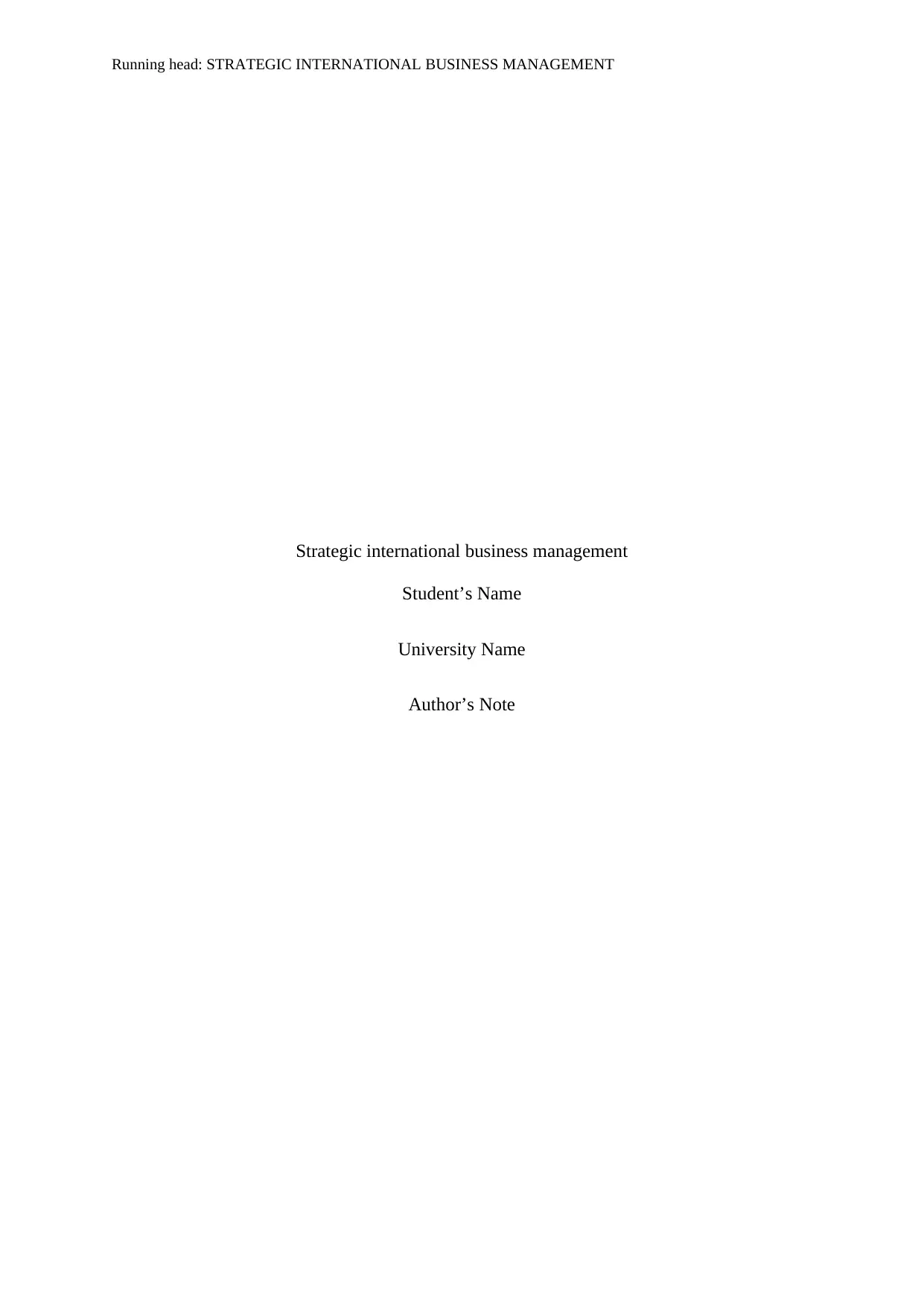
Running head: STRATEGIC INTERNATIONAL BUSINESS MANAGEMENT
Strategic international business management
Student’s Name
University Name
Author’s Note
Strategic international business management
Student’s Name
University Name
Author’s Note
Paraphrase This Document
Need a fresh take? Get an instant paraphrase of this document with our AI Paraphraser

2STRATEGIC INTERNATIONAL BUSINESS MANAGEMENT
Table of Contents
Introduction................................................................................................................................3
Task 1: PESTEL analysis of the wholesale market factors in Mexico......................................3
1.1 Mexico..............................................................................................................................3
1.1.1 Social.........................................................................................................................3
1.1.2 Technological.............................................................................................................4
1.1.3 Political......................................................................................................................4
1.1.4 Economic...................................................................................................................4
1.1.5 Environmental............................................................................................................5
1.1.6 Legal..........................................................................................................................5
1.2 Norway.............................................................................................................................5
1.2.1 Political Factors.........................................................................................................5
1.2.2 Economic Factors......................................................................................................6
1.2.3 Social Factors.............................................................................................................6
1.2.4 Legal Factors..............................................................................................................6
1.2.5 Technological Factors................................................................................................7
1.2.6 Environmental Factors...............................................................................................7
Task 2.........................................................................................................................................7
2.1 Detailed discussion of the PESTEL factors and implications for the selection of Mexican
Market........................................................................................................................................8
2.1.1 Political Factors.........................................................................................................8
Table of Contents
Introduction................................................................................................................................3
Task 1: PESTEL analysis of the wholesale market factors in Mexico......................................3
1.1 Mexico..............................................................................................................................3
1.1.1 Social.........................................................................................................................3
1.1.2 Technological.............................................................................................................4
1.1.3 Political......................................................................................................................4
1.1.4 Economic...................................................................................................................4
1.1.5 Environmental............................................................................................................5
1.1.6 Legal..........................................................................................................................5
1.2 Norway.............................................................................................................................5
1.2.1 Political Factors.........................................................................................................5
1.2.2 Economic Factors......................................................................................................6
1.2.3 Social Factors.............................................................................................................6
1.2.4 Legal Factors..............................................................................................................6
1.2.5 Technological Factors................................................................................................7
1.2.6 Environmental Factors...............................................................................................7
Task 2.........................................................................................................................................7
2.1 Detailed discussion of the PESTEL factors and implications for the selection of Mexican
Market........................................................................................................................................8
2.1.1 Political Factors.........................................................................................................8
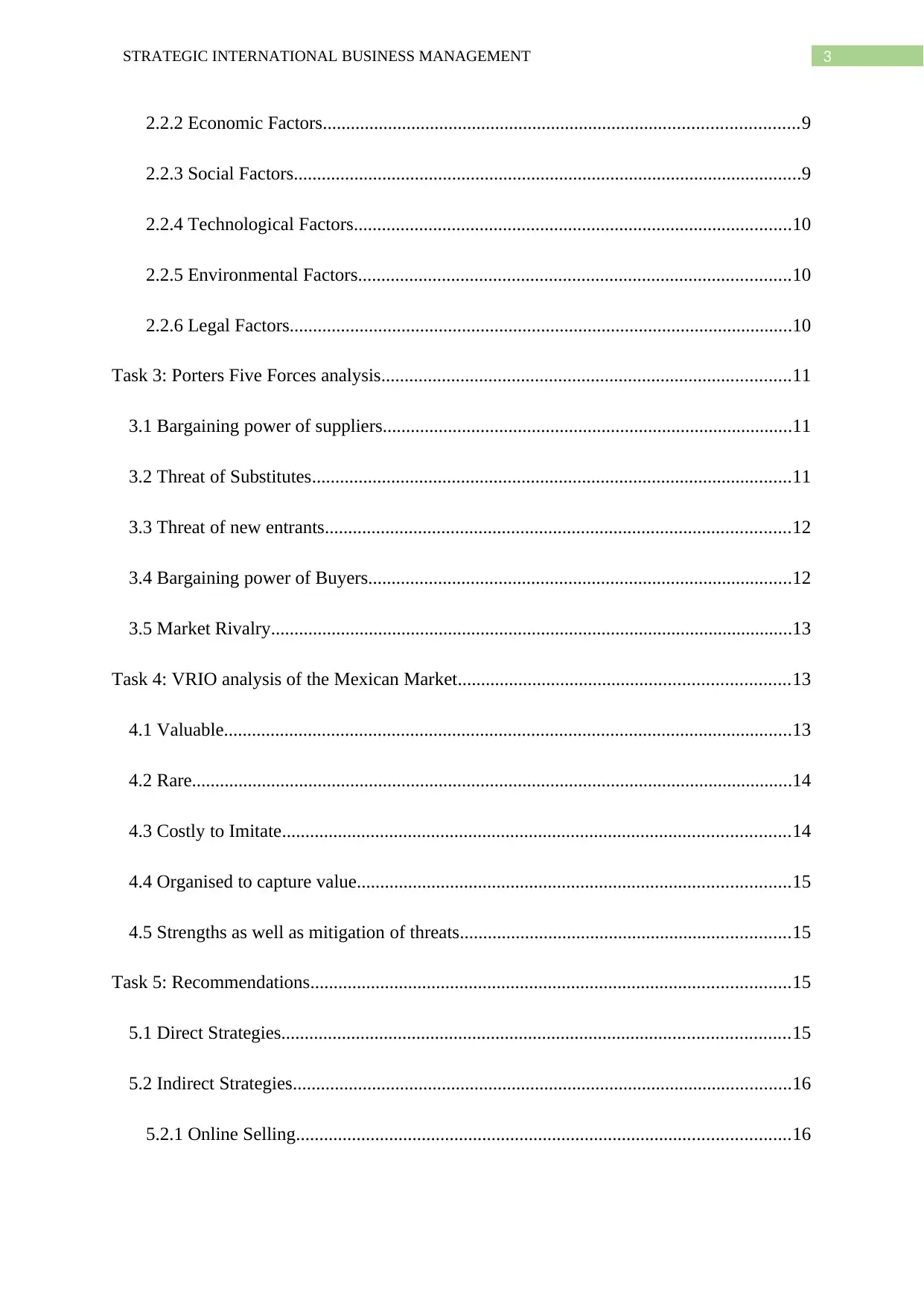
3STRATEGIC INTERNATIONAL BUSINESS MANAGEMENT
2.2.2 Economic Factors......................................................................................................9
2.2.3 Social Factors.............................................................................................................9
2.2.4 Technological Factors..............................................................................................10
2.2.5 Environmental Factors.............................................................................................10
2.2.6 Legal Factors............................................................................................................10
Task 3: Porters Five Forces analysis........................................................................................11
3.1 Bargaining power of suppliers........................................................................................11
3.2 Threat of Substitutes.......................................................................................................11
3.3 Threat of new entrants....................................................................................................12
3.4 Bargaining power of Buyers...........................................................................................12
3.5 Market Rivalry................................................................................................................13
Task 4: VRIO analysis of the Mexican Market.......................................................................13
4.1 Valuable..........................................................................................................................13
4.2 Rare.................................................................................................................................14
4.3 Costly to Imitate.............................................................................................................14
4.4 Organised to capture value.............................................................................................15
4.5 Strengths as well as mitigation of threats.......................................................................15
Task 5: Recommendations.......................................................................................................15
5.1 Direct Strategies.............................................................................................................15
5.2 Indirect Strategies...........................................................................................................16
5.2.1 Online Selling..........................................................................................................16
2.2.2 Economic Factors......................................................................................................9
2.2.3 Social Factors.............................................................................................................9
2.2.4 Technological Factors..............................................................................................10
2.2.5 Environmental Factors.............................................................................................10
2.2.6 Legal Factors............................................................................................................10
Task 3: Porters Five Forces analysis........................................................................................11
3.1 Bargaining power of suppliers........................................................................................11
3.2 Threat of Substitutes.......................................................................................................11
3.3 Threat of new entrants....................................................................................................12
3.4 Bargaining power of Buyers...........................................................................................12
3.5 Market Rivalry................................................................................................................13
Task 4: VRIO analysis of the Mexican Market.......................................................................13
4.1 Valuable..........................................................................................................................13
4.2 Rare.................................................................................................................................14
4.3 Costly to Imitate.............................................................................................................14
4.4 Organised to capture value.............................................................................................15
4.5 Strengths as well as mitigation of threats.......................................................................15
Task 5: Recommendations.......................................................................................................15
5.1 Direct Strategies.............................................................................................................15
5.2 Indirect Strategies...........................................................................................................16
5.2.1 Online Selling..........................................................................................................16
⊘ This is a preview!⊘
Do you want full access?
Subscribe today to unlock all pages.

Trusted by 1+ million students worldwide
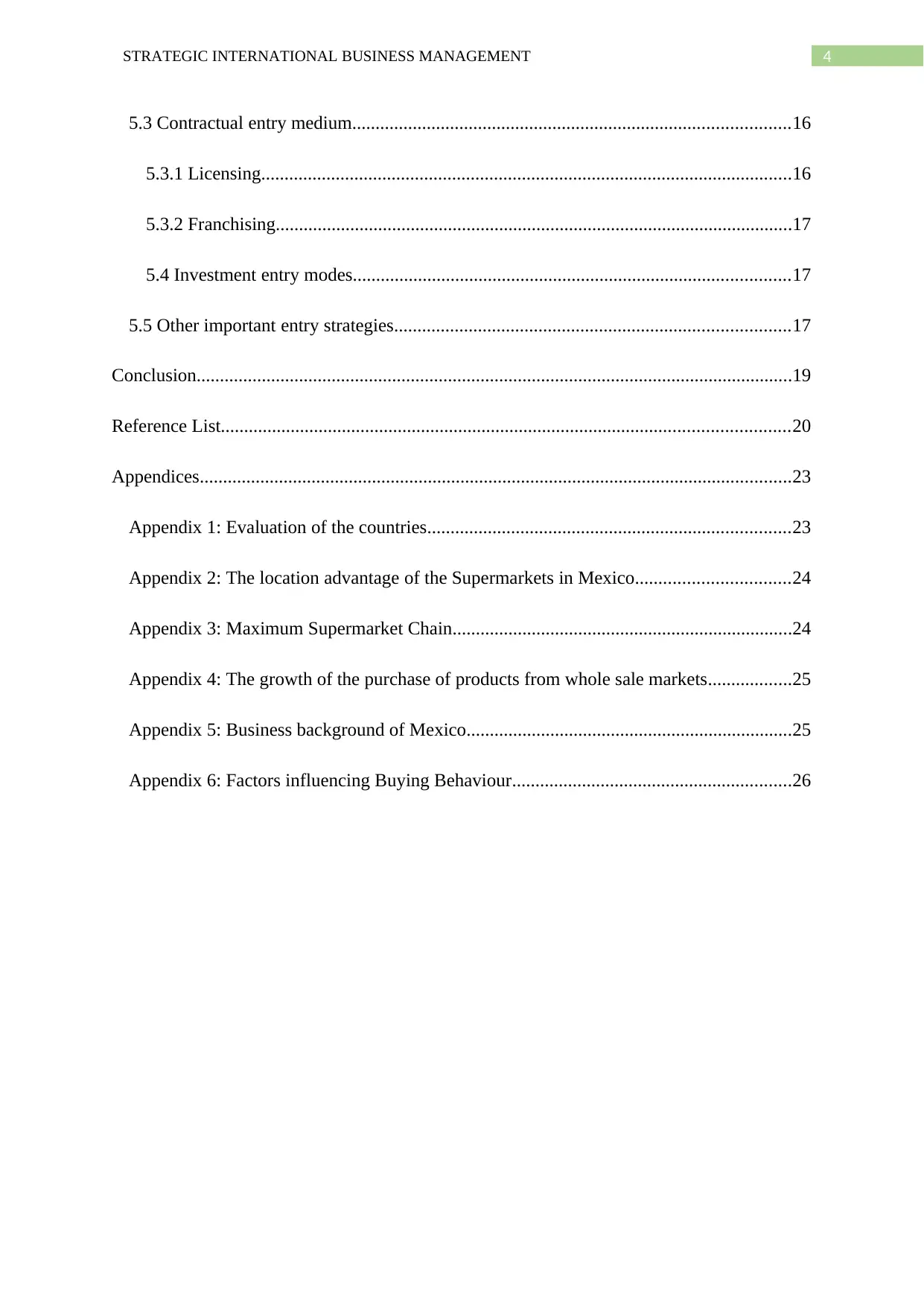
4STRATEGIC INTERNATIONAL BUSINESS MANAGEMENT
5.3 Contractual entry medium..............................................................................................16
5.3.1 Licensing..................................................................................................................16
5.3.2 Franchising...............................................................................................................17
5.4 Investment entry modes..............................................................................................17
5.5 Other important entry strategies.....................................................................................17
Conclusion................................................................................................................................19
Reference List..........................................................................................................................20
Appendices...............................................................................................................................23
Appendix 1: Evaluation of the countries..............................................................................23
Appendix 2: The location advantage of the Supermarkets in Mexico.................................24
Appendix 3: Maximum Supermarket Chain.........................................................................24
Appendix 4: The growth of the purchase of products from whole sale markets..................25
Appendix 5: Business background of Mexico......................................................................25
Appendix 6: Factors influencing Buying Behaviour............................................................26
5.3 Contractual entry medium..............................................................................................16
5.3.1 Licensing..................................................................................................................16
5.3.2 Franchising...............................................................................................................17
5.4 Investment entry modes..............................................................................................17
5.5 Other important entry strategies.....................................................................................17
Conclusion................................................................................................................................19
Reference List..........................................................................................................................20
Appendices...............................................................................................................................23
Appendix 1: Evaluation of the countries..............................................................................23
Appendix 2: The location advantage of the Supermarkets in Mexico.................................24
Appendix 3: Maximum Supermarket Chain.........................................................................24
Appendix 4: The growth of the purchase of products from whole sale markets..................25
Appendix 5: Business background of Mexico......................................................................25
Appendix 6: Factors influencing Buying Behaviour............................................................26
Paraphrase This Document
Need a fresh take? Get an instant paraphrase of this document with our AI Paraphraser
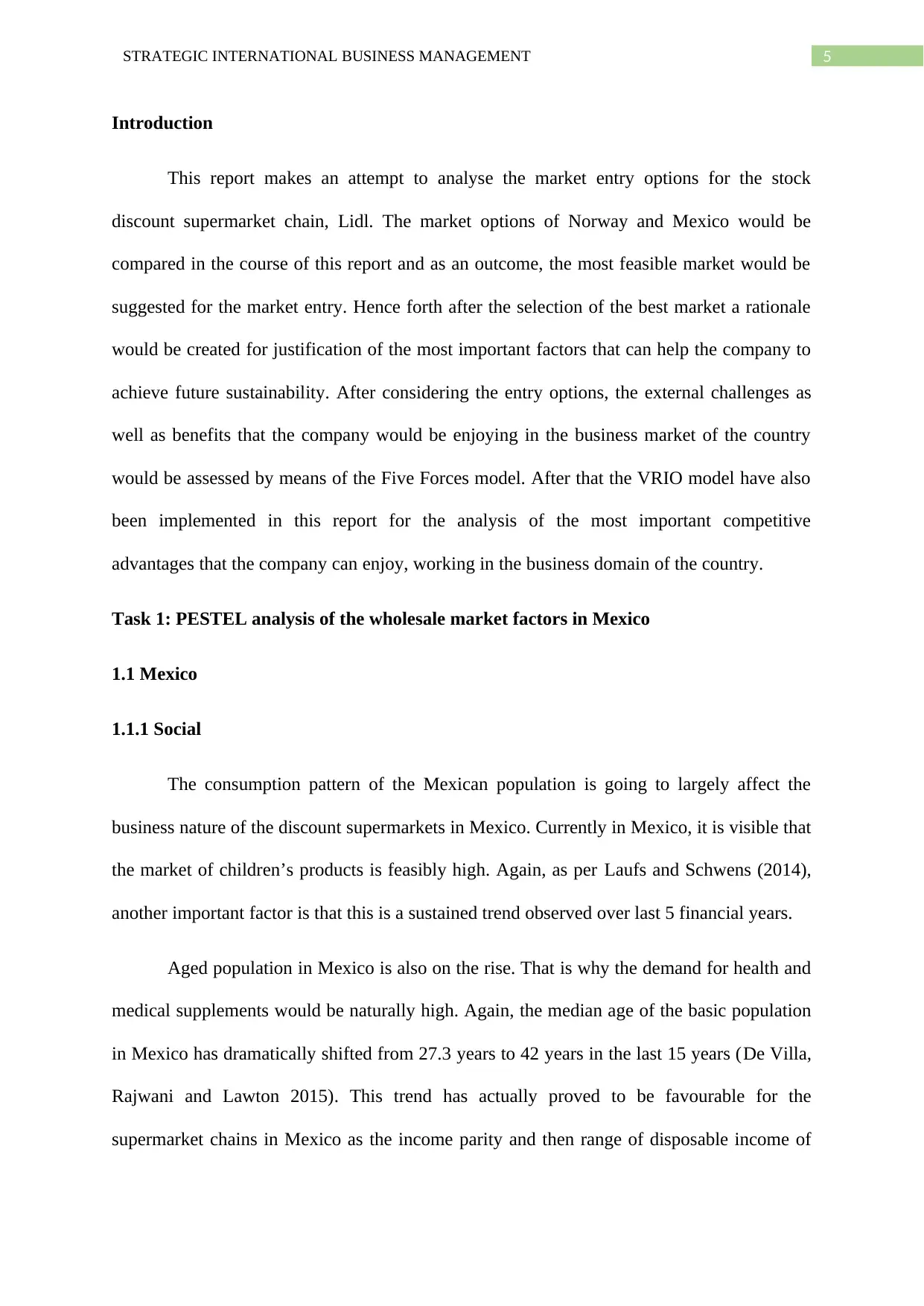
5STRATEGIC INTERNATIONAL BUSINESS MANAGEMENT
Introduction
This report makes an attempt to analyse the market entry options for the stock
discount supermarket chain, Lidl. The market options of Norway and Mexico would be
compared in the course of this report and as an outcome, the most feasible market would be
suggested for the market entry. Hence forth after the selection of the best market a rationale
would be created for justification of the most important factors that can help the company to
achieve future sustainability. After considering the entry options, the external challenges as
well as benefits that the company would be enjoying in the business market of the country
would be assessed by means of the Five Forces model. After that the VRIO model have also
been implemented in this report for the analysis of the most important competitive
advantages that the company can enjoy, working in the business domain of the country.
Task 1: PESTEL analysis of the wholesale market factors in Mexico
1.1 Mexico
1.1.1 Social
The consumption pattern of the Mexican population is going to largely affect the
business nature of the discount supermarkets in Mexico. Currently in Mexico, it is visible that
the market of children’s products is feasibly high. Again, as per Laufs and Schwens (2014),
another important factor is that this is a sustained trend observed over last 5 financial years.
Aged population in Mexico is also on the rise. That is why the demand for health and
medical supplements would be naturally high. Again, the median age of the basic population
in Mexico has dramatically shifted from 27.3 years to 42 years in the last 15 years (De Villa,
Rajwani and Lawton 2015). This trend has actually proved to be favourable for the
supermarket chains in Mexico as the income parity and then range of disposable income of
Introduction
This report makes an attempt to analyse the market entry options for the stock
discount supermarket chain, Lidl. The market options of Norway and Mexico would be
compared in the course of this report and as an outcome, the most feasible market would be
suggested for the market entry. Hence forth after the selection of the best market a rationale
would be created for justification of the most important factors that can help the company to
achieve future sustainability. After considering the entry options, the external challenges as
well as benefits that the company would be enjoying in the business market of the country
would be assessed by means of the Five Forces model. After that the VRIO model have also
been implemented in this report for the analysis of the most important competitive
advantages that the company can enjoy, working in the business domain of the country.
Task 1: PESTEL analysis of the wholesale market factors in Mexico
1.1 Mexico
1.1.1 Social
The consumption pattern of the Mexican population is going to largely affect the
business nature of the discount supermarkets in Mexico. Currently in Mexico, it is visible that
the market of children’s products is feasibly high. Again, as per Laufs and Schwens (2014),
another important factor is that this is a sustained trend observed over last 5 financial years.
Aged population in Mexico is also on the rise. That is why the demand for health and
medical supplements would be naturally high. Again, the median age of the basic population
in Mexico has dramatically shifted from 27.3 years to 42 years in the last 15 years (De Villa,
Rajwani and Lawton 2015). This trend has actually proved to be favourable for the
supermarket chains in Mexico as the income parity and then range of disposable income of
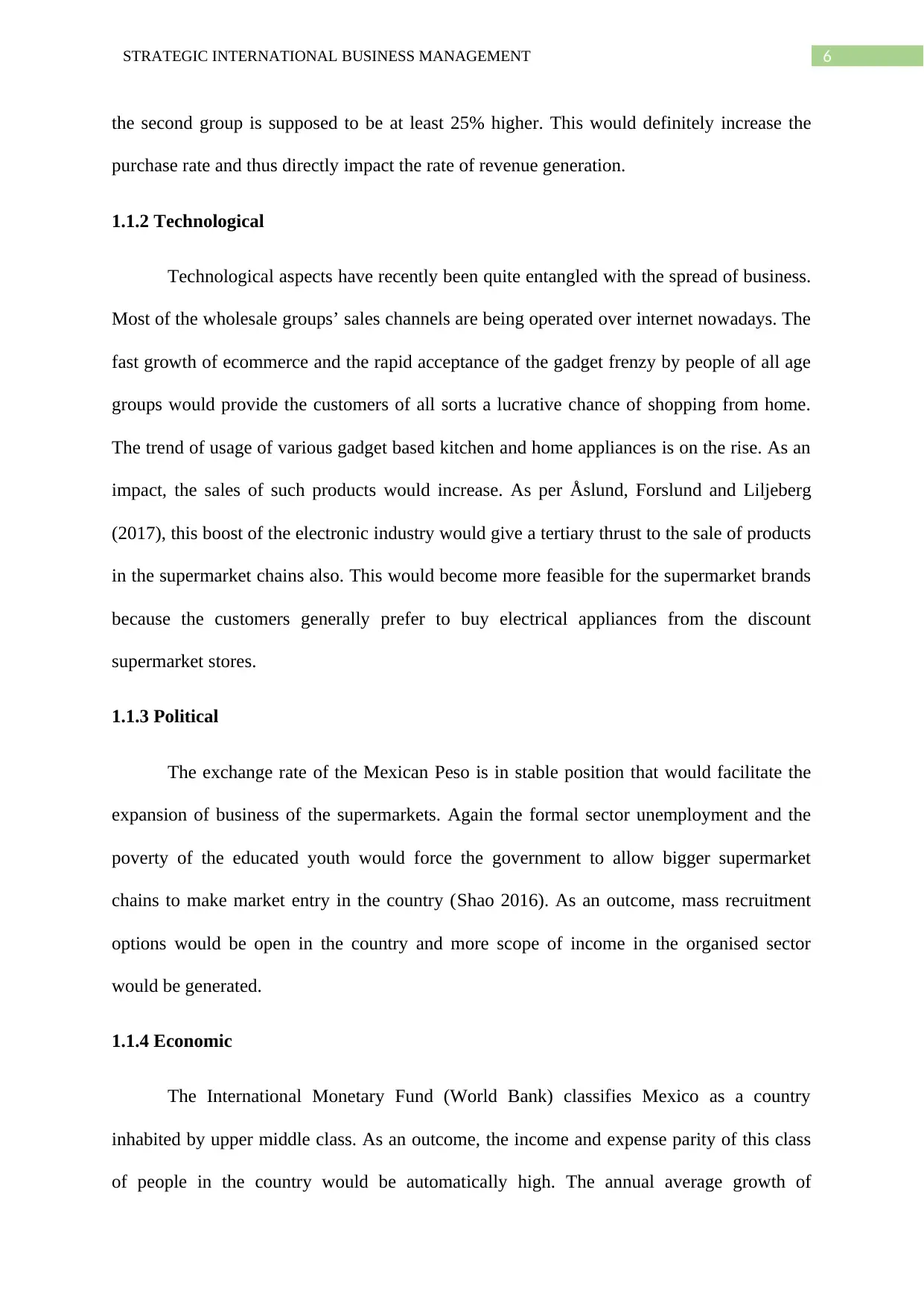
6STRATEGIC INTERNATIONAL BUSINESS MANAGEMENT
the second group is supposed to be at least 25% higher. This would definitely increase the
purchase rate and thus directly impact the rate of revenue generation.
1.1.2 Technological
Technological aspects have recently been quite entangled with the spread of business.
Most of the wholesale groups’ sales channels are being operated over internet nowadays. The
fast growth of ecommerce and the rapid acceptance of the gadget frenzy by people of all age
groups would provide the customers of all sorts a lucrative chance of shopping from home.
The trend of usage of various gadget based kitchen and home appliances is on the rise. As an
impact, the sales of such products would increase. As per Åslund, Forslund and Liljeberg
(2017), this boost of the electronic industry would give a tertiary thrust to the sale of products
in the supermarket chains also. This would become more feasible for the supermarket brands
because the customers generally prefer to buy electrical appliances from the discount
supermarket stores.
1.1.3 Political
The exchange rate of the Mexican Peso is in stable position that would facilitate the
expansion of business of the supermarkets. Again the formal sector unemployment and the
poverty of the educated youth would force the government to allow bigger supermarket
chains to make market entry in the country (Shao 2016). As an outcome, mass recruitment
options would be open in the country and more scope of income in the organised sector
would be generated.
1.1.4 Economic
The International Monetary Fund (World Bank) classifies Mexico as a country
inhabited by upper middle class. As an outcome, the income and expense parity of this class
of people in the country would be automatically high. The annual average growth of
the second group is supposed to be at least 25% higher. This would definitely increase the
purchase rate and thus directly impact the rate of revenue generation.
1.1.2 Technological
Technological aspects have recently been quite entangled with the spread of business.
Most of the wholesale groups’ sales channels are being operated over internet nowadays. The
fast growth of ecommerce and the rapid acceptance of the gadget frenzy by people of all age
groups would provide the customers of all sorts a lucrative chance of shopping from home.
The trend of usage of various gadget based kitchen and home appliances is on the rise. As an
impact, the sales of such products would increase. As per Åslund, Forslund and Liljeberg
(2017), this boost of the electronic industry would give a tertiary thrust to the sale of products
in the supermarket chains also. This would become more feasible for the supermarket brands
because the customers generally prefer to buy electrical appliances from the discount
supermarket stores.
1.1.3 Political
The exchange rate of the Mexican Peso is in stable position that would facilitate the
expansion of business of the supermarkets. Again the formal sector unemployment and the
poverty of the educated youth would force the government to allow bigger supermarket
chains to make market entry in the country (Shao 2016). As an outcome, mass recruitment
options would be open in the country and more scope of income in the organised sector
would be generated.
1.1.4 Economic
The International Monetary Fund (World Bank) classifies Mexico as a country
inhabited by upper middle class. As an outcome, the income and expense parity of this class
of people in the country would be automatically high. The annual average growth of
⊘ This is a preview!⊘
Do you want full access?
Subscribe today to unlock all pages.

Trusted by 1+ million students worldwide
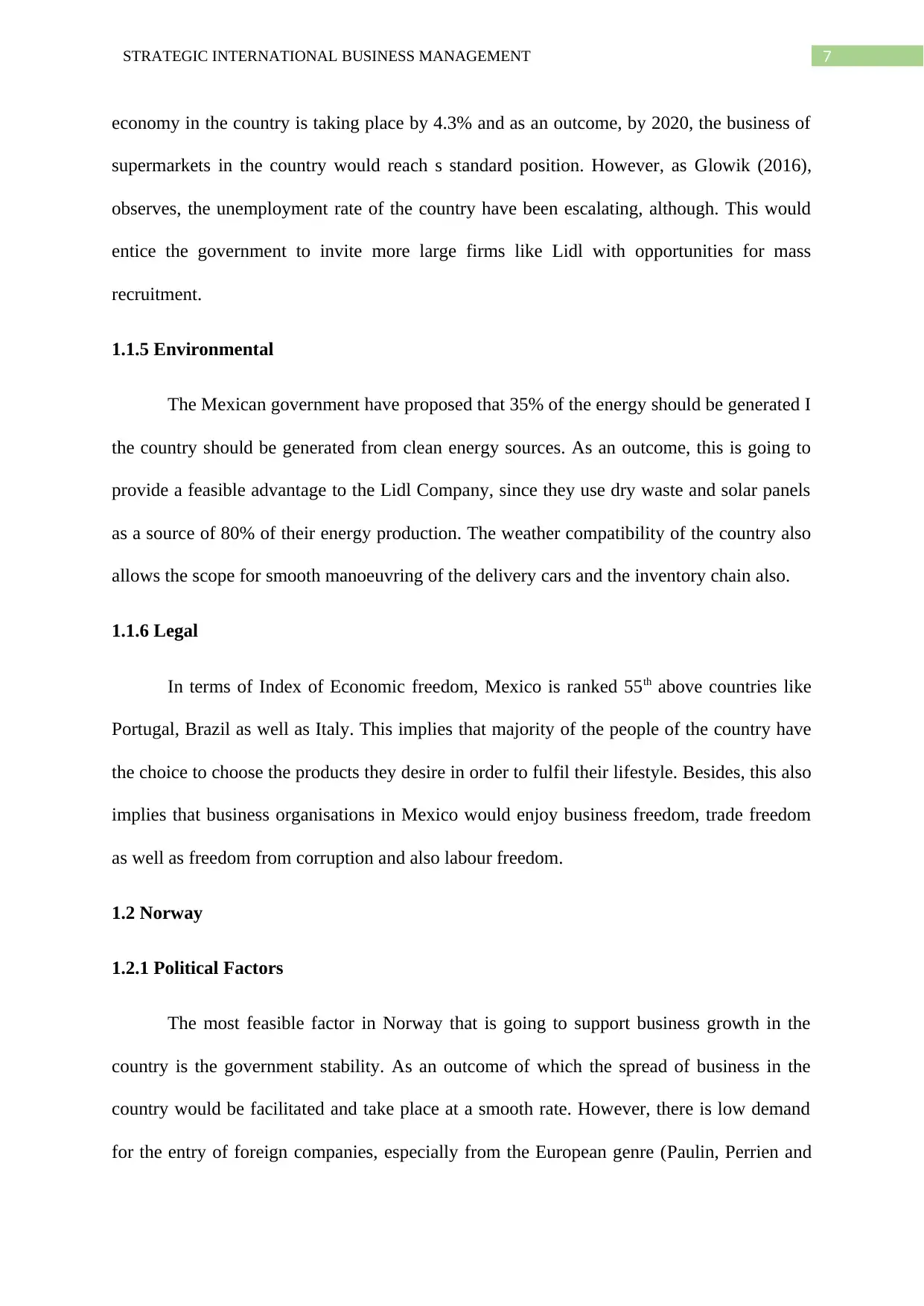
7STRATEGIC INTERNATIONAL BUSINESS MANAGEMENT
economy in the country is taking place by 4.3% and as an outcome, by 2020, the business of
supermarkets in the country would reach s standard position. However, as Glowik (2016),
observes, the unemployment rate of the country have been escalating, although. This would
entice the government to invite more large firms like Lidl with opportunities for mass
recruitment.
1.1.5 Environmental
The Mexican government have proposed that 35% of the energy should be generated I
the country should be generated from clean energy sources. As an outcome, this is going to
provide a feasible advantage to the Lidl Company, since they use dry waste and solar panels
as a source of 80% of their energy production. The weather compatibility of the country also
allows the scope for smooth manoeuvring of the delivery cars and the inventory chain also.
1.1.6 Legal
In terms of Index of Economic freedom, Mexico is ranked 55th above countries like
Portugal, Brazil as well as Italy. This implies that majority of the people of the country have
the choice to choose the products they desire in order to fulfil their lifestyle. Besides, this also
implies that business organisations in Mexico would enjoy business freedom, trade freedom
as well as freedom from corruption and also labour freedom.
1.2 Norway
1.2.1 Political Factors
The most feasible factor in Norway that is going to support business growth in the
country is the government stability. As an outcome of which the spread of business in the
country would be facilitated and take place at a smooth rate. However, there is low demand
for the entry of foreign companies, especially from the European genre (Paulin, Perrien and
economy in the country is taking place by 4.3% and as an outcome, by 2020, the business of
supermarkets in the country would reach s standard position. However, as Glowik (2016),
observes, the unemployment rate of the country have been escalating, although. This would
entice the government to invite more large firms like Lidl with opportunities for mass
recruitment.
1.1.5 Environmental
The Mexican government have proposed that 35% of the energy should be generated I
the country should be generated from clean energy sources. As an outcome, this is going to
provide a feasible advantage to the Lidl Company, since they use dry waste and solar panels
as a source of 80% of their energy production. The weather compatibility of the country also
allows the scope for smooth manoeuvring of the delivery cars and the inventory chain also.
1.1.6 Legal
In terms of Index of Economic freedom, Mexico is ranked 55th above countries like
Portugal, Brazil as well as Italy. This implies that majority of the people of the country have
the choice to choose the products they desire in order to fulfil their lifestyle. Besides, this also
implies that business organisations in Mexico would enjoy business freedom, trade freedom
as well as freedom from corruption and also labour freedom.
1.2 Norway
1.2.1 Political Factors
The most feasible factor in Norway that is going to support business growth in the
country is the government stability. As an outcome of which the spread of business in the
country would be facilitated and take place at a smooth rate. However, there is low demand
for the entry of foreign companies, especially from the European genre (Paulin, Perrien and
Paraphrase This Document
Need a fresh take? Get an instant paraphrase of this document with our AI Paraphraser
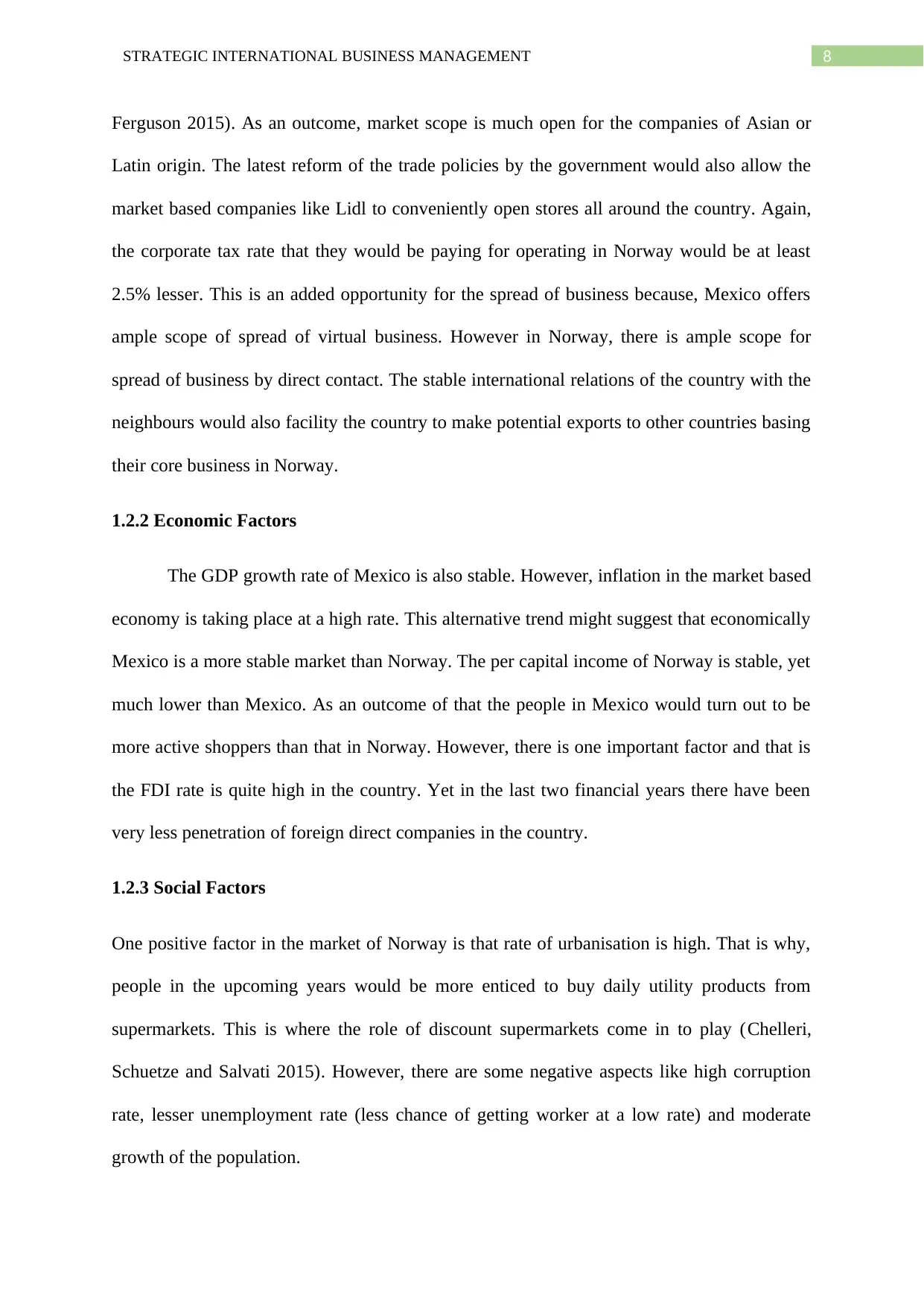
8STRATEGIC INTERNATIONAL BUSINESS MANAGEMENT
Ferguson 2015). As an outcome, market scope is much open for the companies of Asian or
Latin origin. The latest reform of the trade policies by the government would also allow the
market based companies like Lidl to conveniently open stores all around the country. Again,
the corporate tax rate that they would be paying for operating in Norway would be at least
2.5% lesser. This is an added opportunity for the spread of business because, Mexico offers
ample scope of spread of virtual business. However in Norway, there is ample scope for
spread of business by direct contact. The stable international relations of the country with the
neighbours would also facility the country to make potential exports to other countries basing
their core business in Norway.
1.2.2 Economic Factors
The GDP growth rate of Mexico is also stable. However, inflation in the market based
economy is taking place at a high rate. This alternative trend might suggest that economically
Mexico is a more stable market than Norway. The per capital income of Norway is stable, yet
much lower than Mexico. As an outcome of that the people in Mexico would turn out to be
more active shoppers than that in Norway. However, there is one important factor and that is
the FDI rate is quite high in the country. Yet in the last two financial years there have been
very less penetration of foreign direct companies in the country.
1.2.3 Social Factors
One positive factor in the market of Norway is that rate of urbanisation is high. That is why,
people in the upcoming years would be more enticed to buy daily utility products from
supermarkets. This is where the role of discount supermarkets come in to play (Chelleri,
Schuetze and Salvati 2015). However, there are some negative aspects like high corruption
rate, lesser unemployment rate (less chance of getting worker at a low rate) and moderate
growth of the population.
Ferguson 2015). As an outcome, market scope is much open for the companies of Asian or
Latin origin. The latest reform of the trade policies by the government would also allow the
market based companies like Lidl to conveniently open stores all around the country. Again,
the corporate tax rate that they would be paying for operating in Norway would be at least
2.5% lesser. This is an added opportunity for the spread of business because, Mexico offers
ample scope of spread of virtual business. However in Norway, there is ample scope for
spread of business by direct contact. The stable international relations of the country with the
neighbours would also facility the country to make potential exports to other countries basing
their core business in Norway.
1.2.2 Economic Factors
The GDP growth rate of Mexico is also stable. However, inflation in the market based
economy is taking place at a high rate. This alternative trend might suggest that economically
Mexico is a more stable market than Norway. The per capital income of Norway is stable, yet
much lower than Mexico. As an outcome of that the people in Mexico would turn out to be
more active shoppers than that in Norway. However, there is one important factor and that is
the FDI rate is quite high in the country. Yet in the last two financial years there have been
very less penetration of foreign direct companies in the country.
1.2.3 Social Factors
One positive factor in the market of Norway is that rate of urbanisation is high. That is why,
people in the upcoming years would be more enticed to buy daily utility products from
supermarkets. This is where the role of discount supermarkets come in to play (Chelleri,
Schuetze and Salvati 2015). However, there are some negative aspects like high corruption
rate, lesser unemployment rate (less chance of getting worker at a low rate) and moderate
growth of the population.
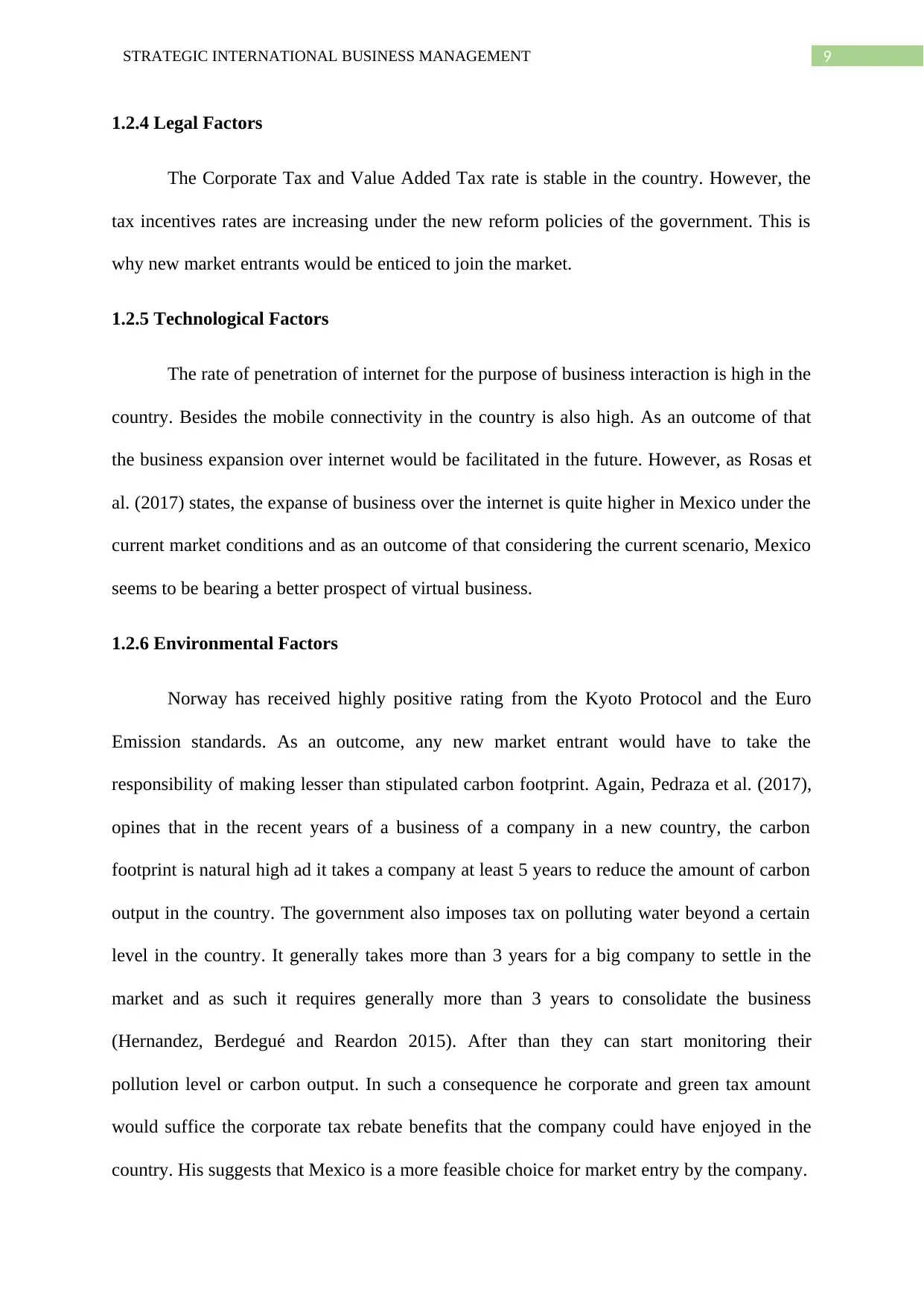
9STRATEGIC INTERNATIONAL BUSINESS MANAGEMENT
1.2.4 Legal Factors
The Corporate Tax and Value Added Tax rate is stable in the country. However, the
tax incentives rates are increasing under the new reform policies of the government. This is
why new market entrants would be enticed to join the market.
1.2.5 Technological Factors
The rate of penetration of internet for the purpose of business interaction is high in the
country. Besides the mobile connectivity in the country is also high. As an outcome of that
the business expansion over internet would be facilitated in the future. However, as Rosas et
al. (2017) states, the expanse of business over the internet is quite higher in Mexico under the
current market conditions and as an outcome of that considering the current scenario, Mexico
seems to be bearing a better prospect of virtual business.
1.2.6 Environmental Factors
Norway has received highly positive rating from the Kyoto Protocol and the Euro
Emission standards. As an outcome, any new market entrant would have to take the
responsibility of making lesser than stipulated carbon footprint. Again, Pedraza et al. (2017),
opines that in the recent years of a business of a company in a new country, the carbon
footprint is natural high ad it takes a company at least 5 years to reduce the amount of carbon
output in the country. The government also imposes tax on polluting water beyond a certain
level in the country. It generally takes more than 3 years for a big company to settle in the
market and as such it requires generally more than 3 years to consolidate the business
(Hernandez, Berdegué and Reardon 2015). After than they can start monitoring their
pollution level or carbon output. In such a consequence he corporate and green tax amount
would suffice the corporate tax rebate benefits that the company could have enjoyed in the
country. His suggests that Mexico is a more feasible choice for market entry by the company.
1.2.4 Legal Factors
The Corporate Tax and Value Added Tax rate is stable in the country. However, the
tax incentives rates are increasing under the new reform policies of the government. This is
why new market entrants would be enticed to join the market.
1.2.5 Technological Factors
The rate of penetration of internet for the purpose of business interaction is high in the
country. Besides the mobile connectivity in the country is also high. As an outcome of that
the business expansion over internet would be facilitated in the future. However, as Rosas et
al. (2017) states, the expanse of business over the internet is quite higher in Mexico under the
current market conditions and as an outcome of that considering the current scenario, Mexico
seems to be bearing a better prospect of virtual business.
1.2.6 Environmental Factors
Norway has received highly positive rating from the Kyoto Protocol and the Euro
Emission standards. As an outcome, any new market entrant would have to take the
responsibility of making lesser than stipulated carbon footprint. Again, Pedraza et al. (2017),
opines that in the recent years of a business of a company in a new country, the carbon
footprint is natural high ad it takes a company at least 5 years to reduce the amount of carbon
output in the country. The government also imposes tax on polluting water beyond a certain
level in the country. It generally takes more than 3 years for a big company to settle in the
market and as such it requires generally more than 3 years to consolidate the business
(Hernandez, Berdegué and Reardon 2015). After than they can start monitoring their
pollution level or carbon output. In such a consequence he corporate and green tax amount
would suffice the corporate tax rebate benefits that the company could have enjoyed in the
country. His suggests that Mexico is a more feasible choice for market entry by the company.
⊘ This is a preview!⊘
Do you want full access?
Subscribe today to unlock all pages.

Trusted by 1+ million students worldwide
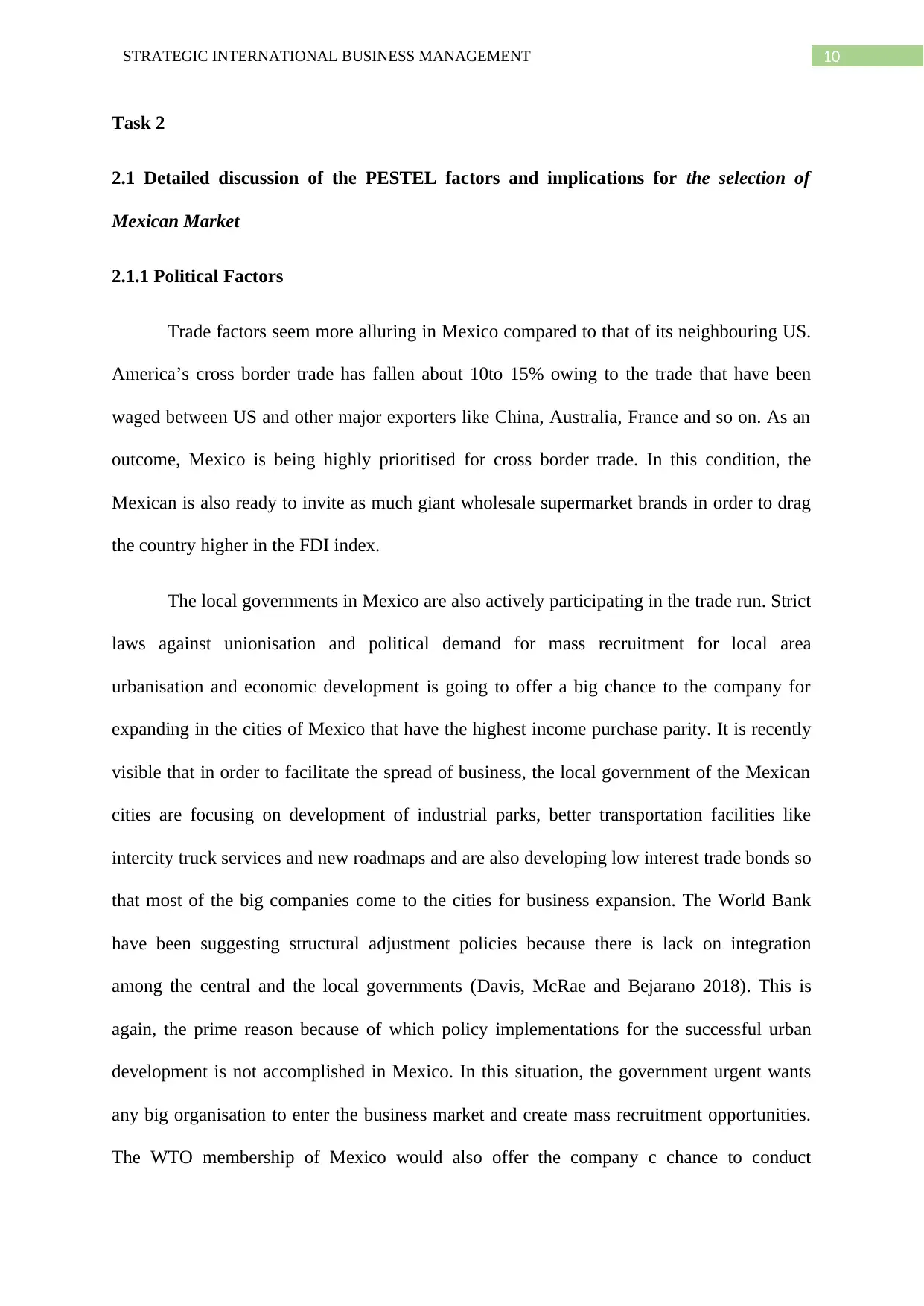
10STRATEGIC INTERNATIONAL BUSINESS MANAGEMENT
Task 2
2.1 Detailed discussion of the PESTEL factors and implications for the selection of
Mexican Market
2.1.1 Political Factors
Trade factors seem more alluring in Mexico compared to that of its neighbouring US.
America’s cross border trade has fallen about 10to 15% owing to the trade that have been
waged between US and other major exporters like China, Australia, France and so on. As an
outcome, Mexico is being highly prioritised for cross border trade. In this condition, the
Mexican is also ready to invite as much giant wholesale supermarket brands in order to drag
the country higher in the FDI index.
The local governments in Mexico are also actively participating in the trade run. Strict
laws against unionisation and political demand for mass recruitment for local area
urbanisation and economic development is going to offer a big chance to the company for
expanding in the cities of Mexico that have the highest income purchase parity. It is recently
visible that in order to facilitate the spread of business, the local government of the Mexican
cities are focusing on development of industrial parks, better transportation facilities like
intercity truck services and new roadmaps and are also developing low interest trade bonds so
that most of the big companies come to the cities for business expansion. The World Bank
have been suggesting structural adjustment policies because there is lack on integration
among the central and the local governments (Davis, McRae and Bejarano 2018). This is
again, the prime reason because of which policy implementations for the successful urban
development is not accomplished in Mexico. In this situation, the government urgent wants
any big organisation to enter the business market and create mass recruitment opportunities.
The WTO membership of Mexico would also offer the company c chance to conduct
Task 2
2.1 Detailed discussion of the PESTEL factors and implications for the selection of
Mexican Market
2.1.1 Political Factors
Trade factors seem more alluring in Mexico compared to that of its neighbouring US.
America’s cross border trade has fallen about 10to 15% owing to the trade that have been
waged between US and other major exporters like China, Australia, France and so on. As an
outcome, Mexico is being highly prioritised for cross border trade. In this condition, the
Mexican is also ready to invite as much giant wholesale supermarket brands in order to drag
the country higher in the FDI index.
The local governments in Mexico are also actively participating in the trade run. Strict
laws against unionisation and political demand for mass recruitment for local area
urbanisation and economic development is going to offer a big chance to the company for
expanding in the cities of Mexico that have the highest income purchase parity. It is recently
visible that in order to facilitate the spread of business, the local government of the Mexican
cities are focusing on development of industrial parks, better transportation facilities like
intercity truck services and new roadmaps and are also developing low interest trade bonds so
that most of the big companies come to the cities for business expansion. The World Bank
have been suggesting structural adjustment policies because there is lack on integration
among the central and the local governments (Davis, McRae and Bejarano 2018). This is
again, the prime reason because of which policy implementations for the successful urban
development is not accomplished in Mexico. In this situation, the government urgent wants
any big organisation to enter the business market and create mass recruitment opportunities.
The WTO membership of Mexico would also offer the company c chance to conduct
Paraphrase This Document
Need a fresh take? Get an instant paraphrase of this document with our AI Paraphraser
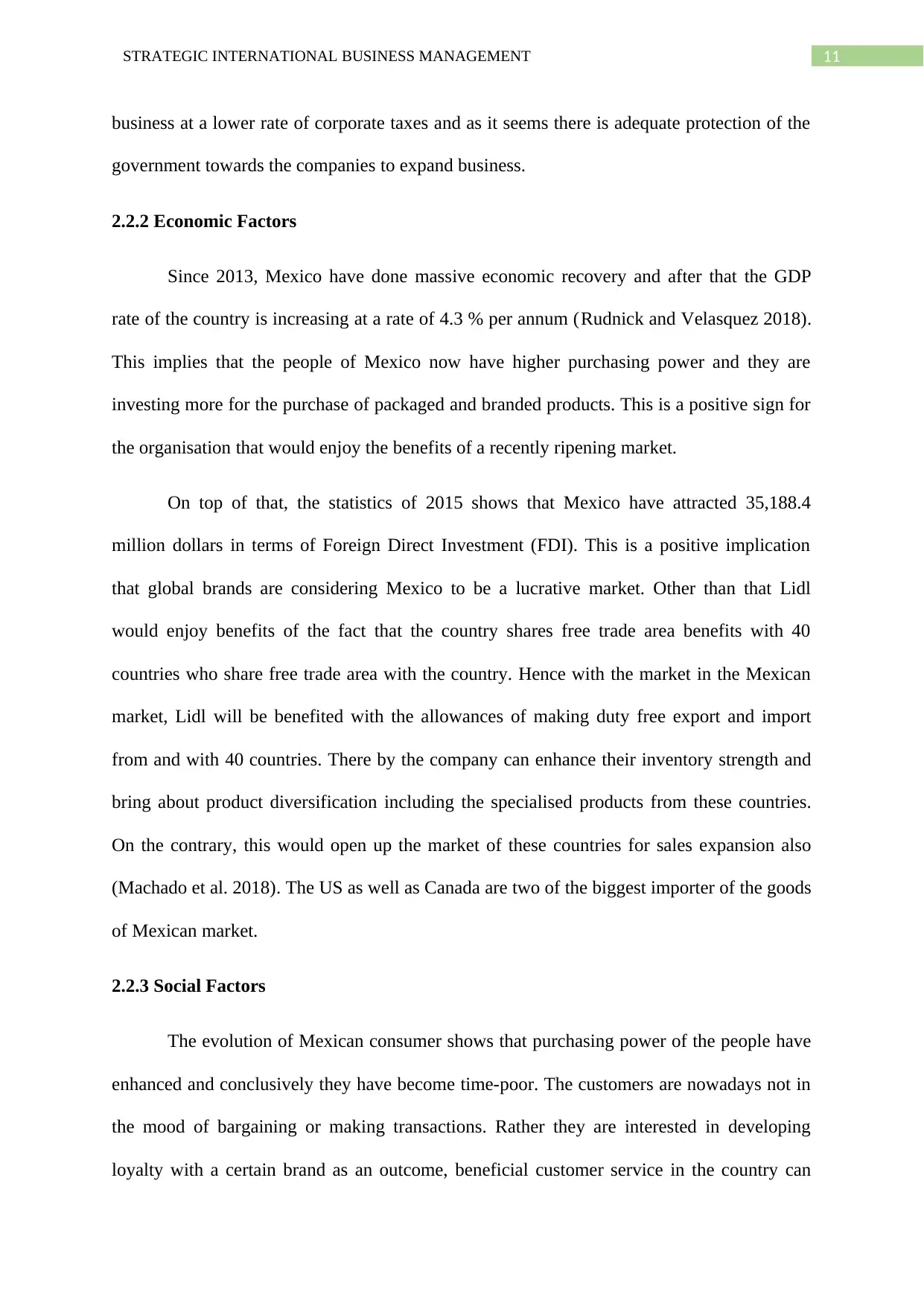
11STRATEGIC INTERNATIONAL BUSINESS MANAGEMENT
business at a lower rate of corporate taxes and as it seems there is adequate protection of the
government towards the companies to expand business.
2.2.2 Economic Factors
Since 2013, Mexico have done massive economic recovery and after that the GDP
rate of the country is increasing at a rate of 4.3 % per annum (Rudnick and Velasquez 2018).
This implies that the people of Mexico now have higher purchasing power and they are
investing more for the purchase of packaged and branded products. This is a positive sign for
the organisation that would enjoy the benefits of a recently ripening market.
On top of that, the statistics of 2015 shows that Mexico have attracted 35,188.4
million dollars in terms of Foreign Direct Investment (FDI). This is a positive implication
that global brands are considering Mexico to be a lucrative market. Other than that Lidl
would enjoy benefits of the fact that the country shares free trade area benefits with 40
countries who share free trade area with the country. Hence with the market in the Mexican
market, Lidl will be benefited with the allowances of making duty free export and import
from and with 40 countries. There by the company can enhance their inventory strength and
bring about product diversification including the specialised products from these countries.
On the contrary, this would open up the market of these countries for sales expansion also
(Machado et al. 2018). The US as well as Canada are two of the biggest importer of the goods
of Mexican market.
2.2.3 Social Factors
The evolution of Mexican consumer shows that purchasing power of the people have
enhanced and conclusively they have become time-poor. The customers are nowadays not in
the mood of bargaining or making transactions. Rather they are interested in developing
loyalty with a certain brand as an outcome, beneficial customer service in the country can
business at a lower rate of corporate taxes and as it seems there is adequate protection of the
government towards the companies to expand business.
2.2.2 Economic Factors
Since 2013, Mexico have done massive economic recovery and after that the GDP
rate of the country is increasing at a rate of 4.3 % per annum (Rudnick and Velasquez 2018).
This implies that the people of Mexico now have higher purchasing power and they are
investing more for the purchase of packaged and branded products. This is a positive sign for
the organisation that would enjoy the benefits of a recently ripening market.
On top of that, the statistics of 2015 shows that Mexico have attracted 35,188.4
million dollars in terms of Foreign Direct Investment (FDI). This is a positive implication
that global brands are considering Mexico to be a lucrative market. Other than that Lidl
would enjoy benefits of the fact that the country shares free trade area benefits with 40
countries who share free trade area with the country. Hence with the market in the Mexican
market, Lidl will be benefited with the allowances of making duty free export and import
from and with 40 countries. There by the company can enhance their inventory strength and
bring about product diversification including the specialised products from these countries.
On the contrary, this would open up the market of these countries for sales expansion also
(Machado et al. 2018). The US as well as Canada are two of the biggest importer of the goods
of Mexican market.
2.2.3 Social Factors
The evolution of Mexican consumer shows that purchasing power of the people have
enhanced and conclusively they have become time-poor. The customers are nowadays not in
the mood of bargaining or making transactions. Rather they are interested in developing
loyalty with a certain brand as an outcome, beneficial customer service in the country can
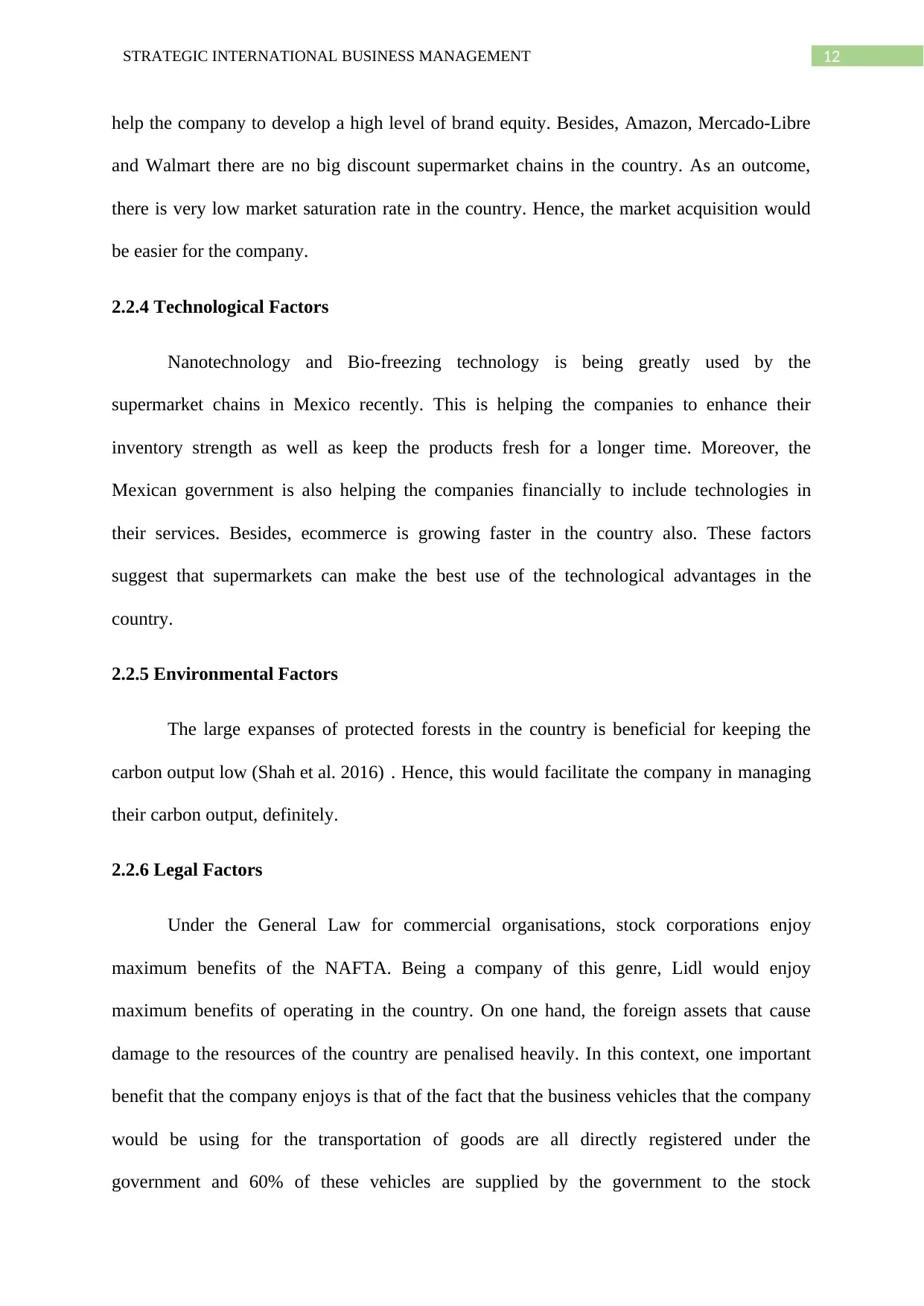
12STRATEGIC INTERNATIONAL BUSINESS MANAGEMENT
help the company to develop a high level of brand equity. Besides, Amazon, Mercado-Libre
and Walmart there are no big discount supermarket chains in the country. As an outcome,
there is very low market saturation rate in the country. Hence, the market acquisition would
be easier for the company.
2.2.4 Technological Factors
Nanotechnology and Bio-freezing technology is being greatly used by the
supermarket chains in Mexico recently. This is helping the companies to enhance their
inventory strength as well as keep the products fresh for a longer time. Moreover, the
Mexican government is also helping the companies financially to include technologies in
their services. Besides, ecommerce is growing faster in the country also. These factors
suggest that supermarkets can make the best use of the technological advantages in the
country.
2.2.5 Environmental Factors
The large expanses of protected forests in the country is beneficial for keeping the
carbon output low (Shah et al. 2016) . Hence, this would facilitate the company in managing
their carbon output, definitely.
2.2.6 Legal Factors
Under the General Law for commercial organisations, stock corporations enjoy
maximum benefits of the NAFTA. Being a company of this genre, Lidl would enjoy
maximum benefits of operating in the country. On one hand, the foreign assets that cause
damage to the resources of the country are penalised heavily. In this context, one important
benefit that the company enjoys is that of the fact that the business vehicles that the company
would be using for the transportation of goods are all directly registered under the
government and 60% of these vehicles are supplied by the government to the stock
help the company to develop a high level of brand equity. Besides, Amazon, Mercado-Libre
and Walmart there are no big discount supermarket chains in the country. As an outcome,
there is very low market saturation rate in the country. Hence, the market acquisition would
be easier for the company.
2.2.4 Technological Factors
Nanotechnology and Bio-freezing technology is being greatly used by the
supermarket chains in Mexico recently. This is helping the companies to enhance their
inventory strength as well as keep the products fresh for a longer time. Moreover, the
Mexican government is also helping the companies financially to include technologies in
their services. Besides, ecommerce is growing faster in the country also. These factors
suggest that supermarkets can make the best use of the technological advantages in the
country.
2.2.5 Environmental Factors
The large expanses of protected forests in the country is beneficial for keeping the
carbon output low (Shah et al. 2016) . Hence, this would facilitate the company in managing
their carbon output, definitely.
2.2.6 Legal Factors
Under the General Law for commercial organisations, stock corporations enjoy
maximum benefits of the NAFTA. Being a company of this genre, Lidl would enjoy
maximum benefits of operating in the country. On one hand, the foreign assets that cause
damage to the resources of the country are penalised heavily. In this context, one important
benefit that the company enjoys is that of the fact that the business vehicles that the company
would be using for the transportation of goods are all directly registered under the
government and 60% of these vehicles are supplied by the government to the stock
⊘ This is a preview!⊘
Do you want full access?
Subscribe today to unlock all pages.

Trusted by 1+ million students worldwide
1 out of 28
Related Documents
Your All-in-One AI-Powered Toolkit for Academic Success.
+13062052269
info@desklib.com
Available 24*7 on WhatsApp / Email
![[object Object]](/_next/static/media/star-bottom.7253800d.svg)
Unlock your academic potential
Copyright © 2020–2026 A2Z Services. All Rights Reserved. Developed and managed by ZUCOL.





